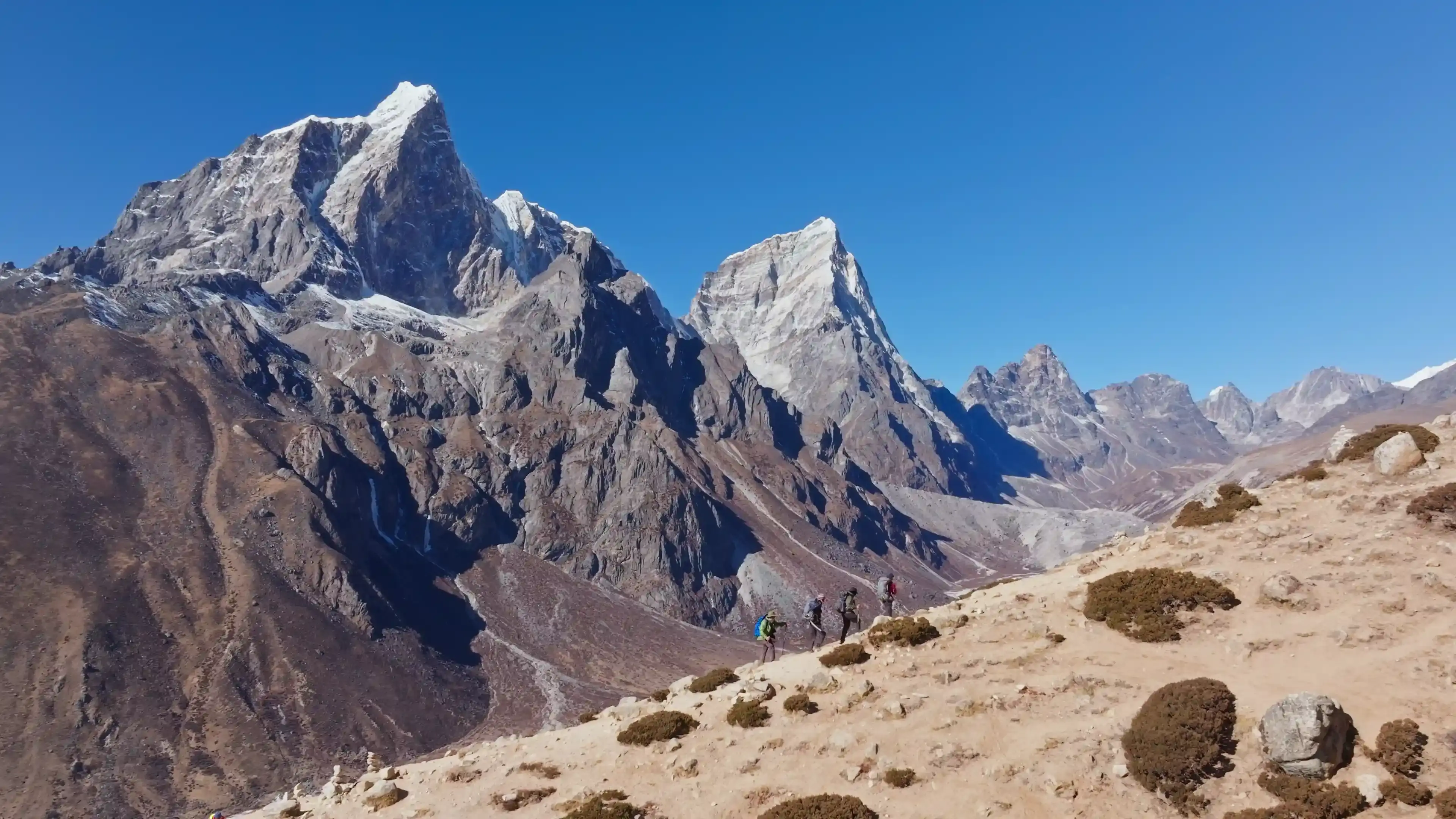Learn how to spot, prevent, and manage altitude sickness—so you can hike higher, safer, and smarter.
Altitude sickness is a real and unpredictable challenge on Nepal’s high-altitude treks, but with the right knowledge, preparation, and trekking partner, it’s entirely manageable. Whether you're heading to Everest, Annapurna, or Langtang, understanding how to prevent, identify, and treat altitude sickness ensures a safe, enjoyable, and successful trekking experience.
Trekking in Nepal is a dream for adventurers around the world — from the iconic Everest Base Camp Trek to the remote Kanchenjunga Circuit and the panoramic Annapurna Circuit. While the majestic Himalayas attract thousands of trekkers every year, they also present a serious challenge: altitude sickness. Also known as Acute Mountain Sickness (AMS), it is one of the most common health risks on high-altitude treks in Nepal.

Acclimatization hike to Nangkartshang Peak (5,083 m / 16,676 ft) above Dingboche during the EBC trek.
At Places Nepal Treks and Expedition, we believe education and preparation are key to safe and successful mountain adventures. This guide will help you understand altitude sickness, its symptoms, causes, prevention strategies, and treatment options — tailored for both beginner and experienced trekkers venturing into Nepal's high-altitude terrain.
What is Altitude Sickness?
Altitude sickness occurs when your body fails to adapt quickly to reduced oxygen levels at higher elevations, typically above 2,500 meters (8,200 feet). The higher you climb, the thinner the air gets — making it harder for your body to function efficiently. If ignored, mild AMS can escalate into more dangerous conditions like:
These advanced forms of altitude illness can be life-threatening without prompt treatment.
Common Symptoms of Altitude Sickness
Altitude sickness symptoms generally begin within 6–24 hours after arriving at a higher altitude. Here are the most common signs to watch out for:
Headache (typically the first symptom)
Dizziness or light-headedness
Shortness of breath during rest
Nausea or vomiting
Loss of appetite
Fatigue or unusual tiredness
Disturbed sleep or insomnia
Swelling of hands, feet, or face
Poor coordination or unsteady walking (in severe cases)
Early detection is crucial. If ignored, even mild symptoms can turn serious, especially above 3,500 meters, which is common in treks like Everest Base Camp, Gokyo Lakes, or the Manaslu Circuit.

Trekkers while crossing the Larkya La Pass (5,106m)
Risk Factors for AMS in Nepal Treks
Several conditions can increase your risk of getting altitude sickness in Nepal:
Rapid ascent without acclimatization
Trekking above 3,000 meters
High sleeping elevation
Lack of hydration
Exerting yourself too quickly
History of AMS on previous treks
How to Prevent Altitude Sickness in Nepal Treks
1. Acclimatize Gradually
The best way to prevent AMS is to gain altitude slowly. Most guided treks with Places Nepal Treks and Expedition follow the “climb high, sleep low” principle and include acclimatization days — especially on high-altitude treks such as:
2. Stay Well Hydrated
Drink at least 3–4 liters of water per day. Dehydration is a major contributing factor to altitude sickness. Avoid alcohol and minimize caffeine intake at high elevations.
3. Fuel Your Body
Eat light but carbohydrate-rich meals to support energy levels. Avoid heavy or greasy food. Dal Bhat — the local Nepali staple — is ideal for trekkers due to its balanced nutrition.
4. Pace Yourself
Trekking too fast is one of the biggest mistakes. Walk slowly, rest frequently, and allow your body to adjust naturally.
5. Use Preventive Medications (If Recommended)
Consider Acetazolamide (Diamox) if you have a history of AMS or are trekking above 4,000m. Consult your doctor before the trek. It helps speed up acclimatization and reduces the chance of illness.
6. Train Before the Trek
Physical fitness doesn’t guarantee immunity to AMS, but it helps. Train with cardio and altitude simulation (if possible) before your Nepal trekking adventure.
Remedies and Treatment for AMS
If symptoms of altitude sickness appear, take action immediately:
➤ Rest and Hydrate
Stop ascending and rest. Mild AMS often improves with rest, water, and food.
➤ Descend
If symptoms worsen or persist after 24–48 hours, descend at least 500 meters. Descent is the most effective cure for AMS.
➤ Oxygen Support
Some treks (especially Everest region) provide bottled oxygen or a portable hyperbaric chamber (Gamow Bag) in emergencies.
➤ Medication
Acetazolamide (Diamox): For prevention and treatment of mild AMS
Dexamethasone: Steroid used for HACE (only under medical guidance)
Ibuprofen/Paracetamol: For headache relief
➤ Natural Remedies
Garlic soup, ginger tea, and local herbal tonics are commonly offered in tea houses to aid breathing and digestion.
However, these are supplemental, not replacements for proper medical action.
Trekking Itineraries That Prioritize Altitude Safety
At Places Nepal Treks and Expedition, we design itineraries that minimize risk by ensuring proper altitude gain, rest days, and experienced guide support. Popular high-altitude treks with built-in acclimatization include:
Travel Insurance for Altitude Sickness in Nepal
Don’t trek without comprehensive travel insurance. It must cover:
Trekking above 5,000 meters
Emergency helicopter evacuation
High-altitude medical care
This is especially vital in remote areas like Dolpo, Makalu, or the Nar Phu Valley, where access to hospitals is limited.
Why Trek with Places Nepal Treks?
Our team consists of licensed guides, first-aid-trained staff, and locally experienced porters. We prioritize slow trekking, health monitoring, and immediate response to any symptoms of altitude-related illness. Your safety is our responsibility.
Plan smart, ascend slowly, and trek with confidence.
For personalized trekking itineraries and altitude-safe adventures, contact Places Nepal Treks and Expedition today.

















